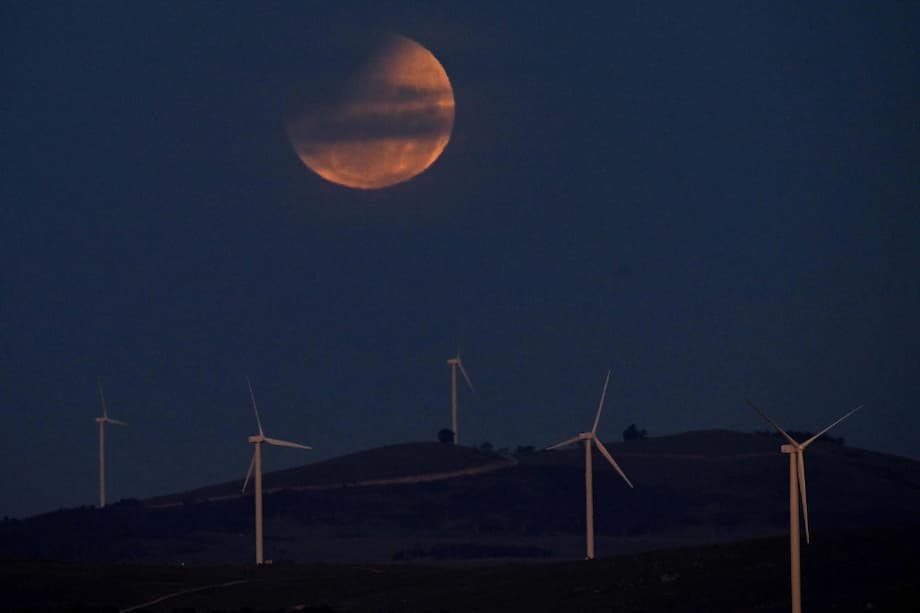A red moon for tsukimi and night sky fans
Japan is set for a striking overnight spectacle as the full moon turns a deep coppery red during a total lunar eclipse in the early hours of Monday (September 8, 2025, Japan time). Astronomers expect 82 minutes of totality, the period when the moon is fully inside Earth’s darkest shadow. The show will be visible across the country, with the clearest views expected in western and southern regions, especially Kyushu. In eastern and northern Japan, the moon will sit lower near the end of the event, yet the blood moon should still be easy to spot if skies are clear.
The eclipse unfolds neatly across the night. The penumbral phase, when the moon first enters Earth’s faint outer shadow, begins at about 12:28 am (JST). The partial phase starts around 1:27 am, when Earth’s umbra, the central shadow, takes a visible bite out of the moon. Totality runs from about 2:30 am to 3:52 am, after which the moon slowly brightens. The final faint shading ends near 5:55 am. These times apply across Japan’s time zone, with only small differences in the moon’s altitude from place to place.
The timing makes this eclipse special for seasonal traditions. Tsukimi, Japan’s autumn moon viewing, spans September and October. This year’s festivities align with a dramatic celestial highlight, the nation’s first widely visible total lunar eclipse since November 2022. An earlier total eclipse in March favored the Americas and the far north of Japan near moonset, but the September event arrives at convenient hours for viewers nationwide.
Unlike solar eclipses, lunar eclipses are safe to watch with the naked eye. Binoculars or a small telescope enrich the view, and even a smartphone can capture memorable images. For those who prefer to stay indoors or in case of clouds, the Gunma Observatory plans a live stream on YouTube, and the Virtual Telescope Project will host coverage online. The eclipse is also visible across Asia, Australia, and large parts of Europe and Africa, while the Americas miss out because the event occurs in their daytime.
When and where to look across Japan
Face the western sky as the night deepens. The moon will darken gradually, then glow red during totality before fading again as it moves out of Earth’s shadow. In western and southern Japan, the moon keeps a more comfortable altitude during totality. In eastern and northern regions, it sits lower toward the west near the end of the event. A clear, unobstructed view toward the western horizon makes a big difference, especially during the final stages before dawn.
Timing by phase
Here are the key moments for Japan (JST): penumbral eclipse begins around 12:28 am, partial eclipse begins about 1:27 am, totality from roughly 2:30 am to 3:52 am, with the penumbral shading fading by about 5:55 am. Totality lasts about 82 minutes. The entire sequence spans nearly six hours from first contact with the penumbra to the final exit.
- Penumbral begins: about 12:28 am
- Partial begins: about 1:27 am
- Totality: about 2:30 am to 3:52 am
- Penumbral ends: about 5:55 am
For animations and a city-by-city view, Time and Date offers a helpful visualization for locations in Japan, including Niigata. See the details here: Time and Date, Japan eclipse page.
Where the view will be best
Weather is the deciding factor, but geography helps. Western and southern regions, including Kyushu, have a favorable view with the moon higher above the horizon during the heart of totality. In Hokkaido and parts of Tohoku, the moon will appear lower as totality ends, so observers should choose open vantage points with a wide view to the west. Urban parks, coastal promenades, and hilltops that face the western sky are ideal.
What makes the moon turn red
A total lunar eclipse occurs when the sun, Earth, and moon align during a full moon, with Earth in the middle. The moon first enters the penumbra, where sunlight is only slightly reduced. It then moves into the umbra, where direct sunlight is blocked. At this stage the lunar disk can glow orange or red instead of disappearing. Sunlight bends through Earth’s atmosphere, which scatters shorter blue wavelengths and lets more red light pass through, painting the eclipsed moon with warm colors.
The exact hue depends on the state of the atmosphere. Dust, smoke, and thin clouds can deepen the red, while a clear atmosphere can yield a brighter orange glow. Volcanic aerosols or widespread dust can mute the moon until it looks dark brick or brownish. This is why no two lunar eclipses look the same, and why observers sometimes compare brightness and color using the Danjon scale, which ranks eclipses from very dark to bright copper.
Close to the start and end of totality, many skywatchers notice a dramatic effect, a narrow bright sliver set against the ruddy disk. Popular astronomy guides call this the Japanese Lantern effect. The pale sliver beside the darker, rusty tones can make the moon look like a glowing lantern floating in the sky. The effect may appear if the atmosphere cooperates and the contrast is strong.
As totality proceeds, the moon dims enough that more stars spring into view. Constellations around Leo and Virgo become easier to see when the moon’s glare fades. Telescopic views during totality often show subtle color gradients, with one limb darker and the opposite limb brighter, depending on how the moon passes through the umbra.
How to watch it safely and comfortably
Lunar eclipses need no special filters or glasses. You can look directly at the moon for as long as you like. That said, a little planning will make the experience far better.
Viewing tips
- Pick a spot with a clear western horizon and minimal light pollution. Rooftops, parks, and coastal viewpoints can be great choices.
- Arrive before the partial phase begins. Allow your eyes several minutes to adapt to the dark.
- Bring binoculars for a closer look at color and shading. A small telescope will reveal fine detail across the lunar surface.
- Use a tripod or a stable surface if you plan to photograph the moon, especially during totality when exposures are longer.
- Dress for cool pre-dawn air and plan for a comfortable wait. A thermos, a chair, and a printed timeline help keep the experience relaxing.
Photography tips
Smartphones can capture the moment if you prepare. Switch to manual or pro mode if available. Set ISO low (around 100 to 400) to keep noise down. During totality, try a shutter speed between about half a second and two seconds, and use a tripod or prop the phone to avoid blur. Tap to focus on the moon or use manual focus if the phone supports it. Bracket exposures at different shutter speeds, since the moon may appear brighter or darker depending on the color of the umbra that night. Telephoto lenses, whether on smartphones or dedicated cameras, will bring out more detail.
If you are using a DSLR or mirrorless camera, start with ISO 200 to 400, aperture around f/4 to f/8, and experiment with shutter speeds from one second down to a tenth of a second during totality. Shorter exposures will be needed during the partial phases and after totality. A remote shutter or timer helps prevent shake. Review shots and adjust as the brightness changes.
Weather, cloud risk and how to follow online
September skies in Japan can be fickle. Historical averages compiled by Time and Date suggest moderate to high cloud cover during the night in several major cities, often in the 60 to 80 percent range in early September. That does not guarantee poor views, because breaks in the cloud can still reveal the moon. Local forecasts are the best guide in the final days and hours, so check your weather app and be ready to relocate to a clearer vantage if possible.
If clouds win, live streams will carry the action. Gunma Observatory plans a broadcast on YouTube, and the Virtual Telescope Project will also stream the eclipse. Useful links include Gunma’s channel and additional global streams: Gunma Observatory on YouTube and Virtual Telescope Project. Time and Date also provides detailed global coverage and maps: Time and Date live coverage.
Who will see it worldwide
Across Asia and Australia, skywatchers will see the eclipse from start to finish in many locations. Much of Europe and Africa will view the event, although in some cities the moon rises already in eclipse, so a clear low horizon is key. The Americas miss this one, since it takes place during daylight on that side of the world. Regional guides list local times for major cities, and several broadcasters will stream the view for audiences outside the visibility zone.
In Southeast Asia, for example, Singapore will see totality from about 1:30 am to 2:52 am local time, with the full sequence playing out across the late night and pre-dawn hours. Across East Asia, including Japan, totality centers on the 2:30 am to 3:52 am window, making it a late night commitment with a reliable payoff if skies are clear.
What comes next for skywatchers in Japan
This year features two total lunar eclipses. The first occurred in March and primarily favored the Western Hemisphere. It also reached parts of northern Japan at moonset. The September event brings prime viewing to the entire country in the middle of the night. Later this month, a partial solar eclipse on September 21 will be visible across parts of Australia and Antarctica, not from Japan.
The next total lunar eclipse visible from Japan arrives on March 3, 2026. Marking key dates now makes it easier to plan, gather with friends or family, and revisit favorite viewing spots discovered during this week’s blood moon.
At a Glance
- Total lunar eclipse over Japan early Monday, September 8, 2025
- Totality lasts about 82 minutes, from around 2:30 am to 3:52 am (JST)
- Event visible nationwide, with best altitude and clarity in western and southern regions
- Penumbral phase starts about 12:28 am, partial phase about 1:27 am, final penumbral shading ends near 5:55 am
- No eye protection needed; binoculars and telescopes enhance the view
- Color depends on atmospheric dust and cloud, so the moon may look orange, red, or brownish
- Average cloudiness in early September can be high, so monitor local forecasts and consider live streams
- Streaming available via Gunma Observatory on YouTube and the Virtual Telescope Project
- Global visibility spans Asia, Australia, and much of Europe and Africa; the Americas miss this eclipse
- Next total lunar eclipse visible in Japan is expected on March 3, 2026




